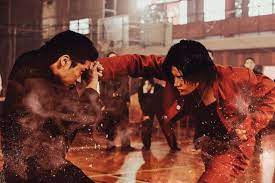


The Japanese Boy Band brawlers “media franchise” “High & Low” may be the craziest thing you ever drop in on as you travel Around the World with Netflix.
It is, in many ways, the classic Japanese “give the people (teen girls especially) what they want” entertainment, attached to an absurdly violent “universe” of high school lads who spend half their time fighting, and the other half getting their hair styled and picking out cool outfits to wear into battle.
“High & Low: The Worst X” is the seventh film in this “franchise,” following TV series that have had half a dozen seasons in assorted incarnations, all of it designed around runway-model lads brawling and bonding with the marketers bragging that “every one is a leading man.”
It’s a film set three years after events in a previous film, with unexplained references to “SWORD” and other entities and alliances of earlier installments. But it’s more or less a stand-alone movie, and it’s pretty much rubbish — shiny, well-shot and edited rubbish, but rubbish none the less.
Some of the set piece fights are reminscent of classic Hong Kong punch-em-ups of the Bruce Lee/Jet Li/Jackie Chan/Donnie Yen variety. But the colorfully-attired “schools” — Oya High, Housen Academy, Senomon Tech — have “The Warriors” vibe.
Unlike the gang bangers fighting their way back home to Coney Island in that 1979 Walter Hill classic, there is no quest for “home,” no allegorical homage to Xenophon’s “Anabasis,” which inspired Sol Yurick’s novel “The Warriors.”
No, this feels like an action franchise produced by a marketing department, cast by a modeling agency and costumed by a fast-fashion clothier. The only thing allegorical about this simplistic tale of “who’s the toughest fighter” tests, factions fighting and allying with each other and a rich kid sort of manipulating the many high school gangs of Taoru City is what the films might be saying about modern Japan.
The world presented here has no cops, no teachers, no classes in these graffiti-covered schools and hideouts, and no girls or adult women.
Yes, it’s occasionally homoerotic. It might seem too violent for high school girls to get into, but maybe girls in the Land of the Rising Son are raised on “A Clockwork Orange.” Still, if you wonder about Japan’s population loss and general, decades-long decline and post-peak malaise, there might be a clue in this nonsensical monoculture where boys will be boys and the fairer sex is never ever seen, only pandered to in the sea of pretty boys cast in the thing.
Fight choreographer/action directors Takahito Ôuchi and Masaki Suzumura do their best to stage and shoot some epic brawls as the brash Fujio (Kazuma Kawamura) of the Oya School gang tries to get a meeting with the legendarily tough Rao, who is absent for most of the film, but who makes a Ryan Reynolds entrance (he even resembles RR) in the third act.
There must be 40 or 50 characters identified by name and school in this movie, many of them getting a credit freeze-frame credit in the “High & Low” opening, but the film’s IMDb page is woefully inadequate, with many the most important characters not listed. Several characters have several different ways of being addressed in the film, adding to the confusion. And the film’s on-screen credits are only available in Japanese (same with the dialogue, which at least has subtitles).
So no, I’m not going to wade through the long list of actors and the archetypes they play — the quiet, bespectacled “smart” fighter, his “fishing buddy,” the deadly dress-alike-duo, the rich punk whose father bought out another man’s company, forcing the bankrupt fellow to become the kid’s driver and the driver’s son, Saboten (Ikuya Naganuma) to be the punk’s insanely-tough high school gang bodyguard.
“Let’s get this brawl started.”
“Dibs on kicking your ass!”
Some performers are great brawlers and others plainly the beneficiaries of “Let’s not show him fighting much” protective editing.
Every fight has its moments where you think, “That haymaker would break every knuckle in that hand” and others that give-away the game (obvious stage punches).
Groups of guys are constantly striking album cover poses or walking into the frame in perfectly aligned slo-mo. It’s all so pretty, even the bloody bits.
But none of the care taken with the visuals and potential poster shots of all the over-styled “stars” trickled down to the screenplay, with only the occasional snappy come-back making us forget the lack of a plot, logic, character motivation (in most cases) or sense that any of this means a damned thing.
“The Worst X?” Let’s hope so.
TV-MA, violence and lots of it
Cast: Kazuma Kawamura, Ikuya Naganuma, and Yuta.
Credits: Directed by Norihisa Hiranuma and Daisuke Ninomiya, scripted by Norihisa Hiranuma, Shôichirô Masumoto and Kei Watanabe. A Netflix release.
Running time: 1:59


